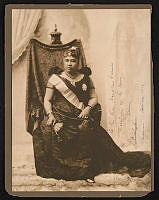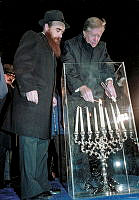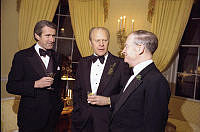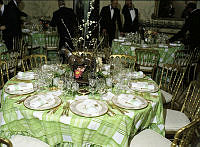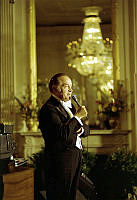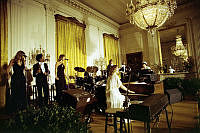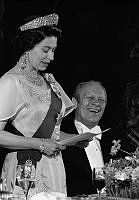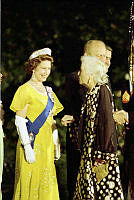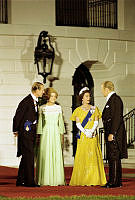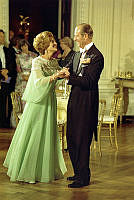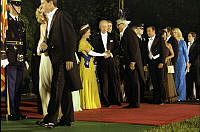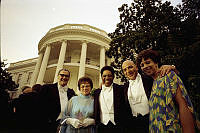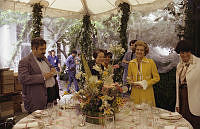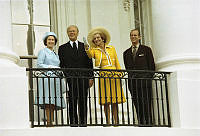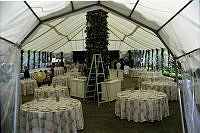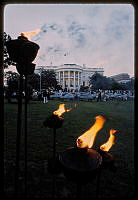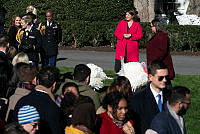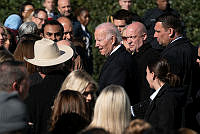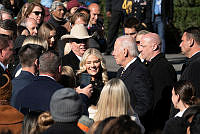The Company Dining Room
A Brief History of the State Dining Room
Copyright © White House Historical Association. All rights reserved under international copyright conventions. No part of this article may be reproduced or utilized in any form or by any means, electronic or mechanical, including photocopying, recording, or by any information storage and retrieval system, without permission in writing from the publisher. Requests for reprint permissions should be addressed to books@whha.org

The State Dining Room in 2015 after its refurbishment. The project was funded by the White House Historical Association.
The White House Historical AssociationDuring the nineteenth century, a series of “state dinners” were held every winter social season to honor Congress, the Supreme Court, and members of the diplomatic community. In recent times, the term “state dinner” has come to mean more specifically a dinner hosted by the president honoring a foreign head of state as the guest of honor. The State Dining Room, which now seats as many as 140 guests, was originally much smaller and served at various times as a drawing room, office, and Cabinet Room. Not until the Andrew Jackson administration was it called the “State Dining Room,” although previous presidents had used it for formal dinners. In early times, this room was called simply the “company dining-room” to distinguish it from the Family Dining Room across the hall.1
Today’s State Dining Room incorporates the space that President Thomas Jefferson used as a private office. Tall and generously proportioned, the room had fireplaces on the east and west walls and was flooded with daylight through tall south and west windows. When President James Madison and First Lady Dolley Madison took residence in 1809, the room became an art gallery and dining area. They displayed Gilbert Stuart’s portrait of George Washington, now in the East Room, on its walls. Mrs. Madison ordered the painting to be removed before the British arrived to burn the house in 1814.

President Thomas Jefferson’s office, in the southwest corner of the house, was where he worked with his secretary, Meriwether Lewis, who would later lead the Lewis and Clark Expedition. “A Bird That Whistles,” by artist Peter Waddell, 2007.
Peter Waddell for the White House Historical AssociationIn April 1840, Whig Congressman Charles Ogle of Pennsylvania launched a venomous and detailed condemnation of President Martin Van Buren’s White House lifestyle on the House floor. “In my opinion,” Ogle said, “it is time the people of the United States should know that their money goes to buy for their . . . President, knives, forks, and spoons of gold, that he may dine in the style of the monarchs of Europe.” Ogle described the State Dining Room in his speech: “The Court Banqueting room also possesses a great variety of very rich and valuable furniture, such as mirrors, mahogany chairs, gilt cornices, window curtains, bronze bowl lamps, antique patterns, gilded, carved and garnished with stars and swan necks….Indeed, there is scarcely anything wanting to make the Court Banqueting room resemble in its style and magnificence the banqueting halls of the Oriental monarchs.” Ogle’s “Gold Spoon Oration” denouncing the palatial Van Buren White House was widely reprinted in Whig-leaning newspapers and in pamphlet form to be distributed by Whig campaigners, and contributed to the president’s defeat in the 1840 election.2
As early as 1856, a reporter wrote that the State Dining Room was too small for the number of congressmen, diplomats, and other distinguished guests. The Cross Hall was used for large dinners even though drafts from the front door made it chilly. Seating for dinners was a matter of studied concern. Guests and their partners marched in unison with music to the table and places arranged by a seating chart reflected diplomatic rank. The president was served first, and no one could rise to leave the table before him.3

A State dinner for the British High Joint Commissioners in 1871 illustrated by Frank Leslie’s Illustrated Newspaper.
White House Collection/White House Historical AssociationPresident Rutherford B. Hayes and Lucy Hayes abstained from alcohol and often served soft drinks instead of liquor at White House dinners and receptions. By the close of the Hayes administration in 1881, teas had become a central part of White House entertaining and Mrs. Hayes had acquired the nickname “Lemonade Lucy.”4
President Chester Arthur commissioned Associated Artists, of which Louis Comfort Tiffany was a partner, to make over the house in 1882. By far the greatest cost in the State Dining Room was Tiffany’s artistic painting. The walls were painted in many shades and textures of yellow and highlighted in silver. The Century Magazine in 1884 commented “the State Dining-room, only used when large companies are entertained at dinner—[is] a rather chilling apartment in spite of the glowing yellows Mr. Tiffany has given to the walls.”5

The State Dining Room around 1890 during the Benjamin Harrison administration.
Library of CongressDuring the 1902 renovation, President Theodore Roosevelt greatly enlarged the State Dining Room. The current woodwork, eagle side pedestal tables, chairs, and lighting fixtures remain from the 1902 renovation. The reconstructed State Dining Room included paneled walls of oak, silver electric light fixtures, a great stone fireplace mantel, and window treatments of green velvet. Flemish tapestries of the sixteenth century, illustrating passages from “Eclogues of Virgil” harmonized with the oak and the richly carved cornice was ornamented with heads of moose, deer, and other animals from American hunting grounds.6 In 1909, Roosevelt ordered the carvings on the main stone mantel to be changed from lions to North American bison heads. Architect Glenn Brown, the superintendent of the McKim, Mead and White renovation of the White House, described the finished room as “a stately hall of the English Renaissance” that had replaced “a State Dining Room [that] had been decorated and furnished like one of the better-class boarding houses so well-known in Washington.”7

The State Dining Room was enlarged in 1902 and redesigned with oak paneling, animal heads, and tapestries that evoked a stately English home.
Library of Congress Changes to the State Dining Room were minor for several decades after 1902. The thirteen game trophies—bought from a New York City collector and dealer and not bagged from President Roosevelt’s hunts as many visitors assumed—were removed during the Warren G. Harding administration. In the final year of World War II, President Franklin D. Roosevelt ordered John Adams’ famous blessing carved on the stone fireplace of the State Dining Room where it can be seen today. On November 2, 1800, Adams wrote to his wife:

State Dining Room redecorated after the Truman Renovation as it appeared set up in 1960 for a dinner for the King and Queen of Denmark.
National Geographic Society“I pray Heaven to bestow the best of Blessings on this House and on all that shall hereafter inhabit it. May none but honest and wise Men ever rule under this roof.”
Franklin D. Roosevelt also hung George P. A. Healy’s 1869 portrait of Abraham Lincoln, donated to the White House in 1939, above the mantel where it remains today. In 1948, Harry S. Truman appointed a Commission on the Renovation of the Executive Mansion that decided to retain the original stone walls, the third floor, and the roof, while removing and then reinstalling the interiors within a skeleton of steel structural beams on a new concrete foundation. Of the State Floor rooms, only the State Dining Room walls were reinstalled, but then were painted a light celadon green to hide damage marks and a new black marble mantel was installed.
In 1962, the Kennedys had a replica of the 1902 mantel, complete with bison heads and the Adams’ quote, installed in the State Dining Room and painted the walls ivory white as part of an extensive program to revive the historic character of the White House.

The State Dining Room in 1962 after the Kennedy redecoration.
White House Historical AssociationThe State Dining Room has been refurbished many times in its history, often with new rugs, draperies, and upholstery fabric. The last refurbishment was in 1998 and by 2010, the rugs needed to be replaced, so in 2012 new rugs were custom-made to a new design. Complementary draperies and historically-inspired chairs were installed in 2015. The White House completed the refurbishment of the State Dining Room on Monday June 15, 2015, in accordance with plans approved by the Committee for the Preservation of the White House. The project was underwritten by the White House Endowment Trust, a fund administered by the White House Historical Association for the maintenance and beautification of the public rooms. Today, the State Dining Room serves as a banquet hall and ceremonial chamber for all manner of official events. It is the center of White House hospitality.

The State Dining Room in 2016.
White House Historical Association












